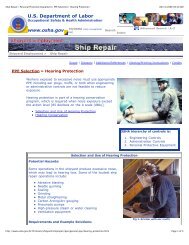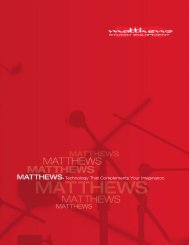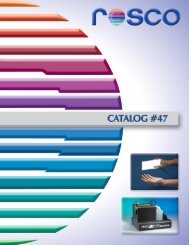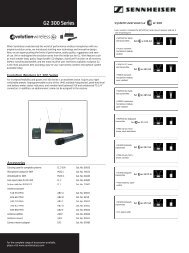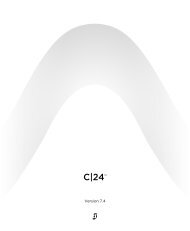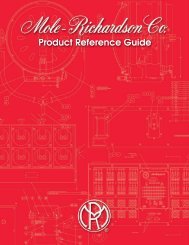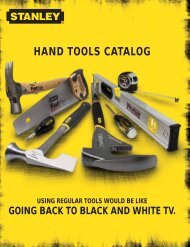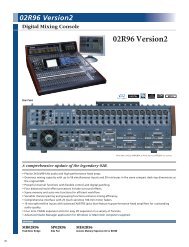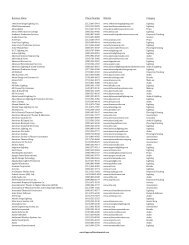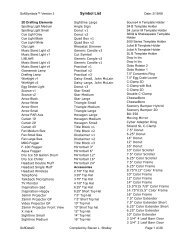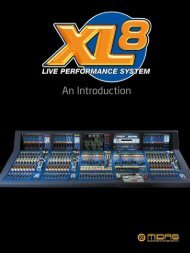Current Catalog - John S. Hyatt & Associates, Inc.
Current Catalog - John S. Hyatt & Associates, Inc.
Current Catalog - John S. Hyatt & Associates, Inc.
- No tags were found...
You also want an ePaper? Increase the reach of your titles
YUMPU automatically turns print PDFs into web optimized ePapers that Google loves.
©JAMES THOMAS ENGINEERING, INC.®TRUSS USER INSTRUCTIONSA. DESIGN REQUIREMENTS FOR TRUSSDetermine the type of truss required to do the job. Check the load requirements for the job carefully to determine the exactload on any truss run. Make sure that the truss is capable of lifting the required loads. Refer to the structural engineering report forloading information.Make sure you have the loading figures for your truss, which is in the back of the structural report book, if you do not havethe information contact James Thomas Engineering.Make sure you fully understand the loading figures, if in doubt ask.When mixing the old flat Camloc plate truss with the newer flanged Camloc plate truss, ensure that loading figures aretaken from the flat Camloc plate truss structural engineering report.Determine the amount of weight loading on flying points as this will have a bearing on the truss type used. Do not forget totake the whole weight of the rig including the hoists into consideration, when determining how much weight is to be suspendedfrom each flying point.If the truss is being rigged permanently, then we suggest that high tensile M16 nut and bolt sets (or the U. S. equivalent tothese sets) are used to join the truss sections.B. HANDLING AND TRANSPORTATIONTruss is generally a reliable maintenance free product. When used within its designed loading parameters and handledwith care, truss will have a long operating life.Do not drop truss as this will cause ends to deform. If dropped the truss will not operate correctly. Each section is designedto transfer load through the top tubes as well as the Camloc fixings. Therefore it is imperative that the ends are circular,Do not drag the truss as this will cause the tubes to pit and aluminum to be shaved off.When possible store truss upright with the female Camlocs facing down (never the male). If truss is to be storedhorizontally it is advisable to stack the truss with pieces of wood in between each section.When loading or unloading be sure you have enough people to load the truss so that the above doesn't happen.Additionally there are recommendations for the weights that an individual should carry without harm. Stick to those limits. Do notdrag truss over other trusses as this will cause damage to tubes and diagonals.C. GENERAL INSPECTION OF TRUSS BEFORE EACH USEDo not use truss if:ACTIONi. Any welds have cracks in them. Refer to JTEii. Any of the end Camloc plates are bent.Refer to JTEiii. Camloc male studs show visible sign of twist. Replace as necessaryiv. Camloc crosspins are bent or missing.Replace as necessaryv. Female Camloc receptacles are loose. Tighten retaining screws and nutsvi. Crosspins in new QRB Camlocs are bent or missing Replace as necessary(These are designed to break before bolt is damaged)vii. High tensile M16 nuts & bolts are worn.Replace as necessary(Every time any nut & bolt is used some thread is lost)viii. There are any dents in the main tubes and diagonals. Refer to JTEix. Truss is badly chewed by wing bolts.Refer to JTE(Exercise care when using Hook clamps)D. RIGGINGAssembly of truss should be done by competent personnelwho are familiar with the use and assembly of aluminum truss.Ensure that one person is responsible for making sure all theCamlocs, nuts and bolts are tightened correctly. Ensure that thisperson is responsible for rigging the span sets and flying points so asnot to put the truss in any danger of being overloaded. One individualshould be overall responsible for the whole rig.Truss must run with the diagonals visible at the sides. Wheresections are joined the diagonals "must form a continuous pattern"see figure here.Note: Diagonals mustform a continuous pattern



